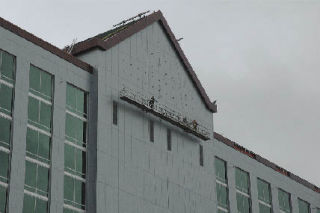TULALIP — Firefighter rescue tech Matt Campbell said he had no qualms in being the first to dangle over the edge of the 12-story Tulalip Hotel.
“It doesn’t bother me,” said Campbell, who’s done rescue drills off the top of the Space Needle in Seattle.
“The first step is the hardest,” said Marysville Fire District 12 Battalion Chief Scott Goodale. “After that, you that you trust your guys.”
Firefighters from Marysville Fire District 12 and the Everett Fire Department both took part last week in high altitude rescue drills off the side of the Tulalip Hotel even as construction of the building continued.
“This is the perfect opportunity to work on a building like this,” Goodale said.
All of the firefighters who were involved are members of the Snohomish County Technical Rescue Team’s Zone 12, which includes Marysville and Tulalip. At least for Tuesday’s drills, Goodale oversaw the action. Rescue workers took their turns hanging out on the side of the new hotel over three days last week.
“This is our first high rise for our district and that’s why we’re putting a lot of effort into this,” Goodale said.
After rappelling about half way down the side of the hotel, Campbell just sort of dangled, playing the part of a victim awaiting rescue, in this case from firefighter rescue tech Jason Tucker. Both Tucker and Campbell are members of Marysville Fire District 12.
All in all, it took Tucker about 15 minutes to reach Campbell, who said hanging by a thread isn’t exactly a comfy spot to be in, but not what he would call terrible either.
“The harness gets uncomfortable,” he said.
Still, Campbell admits he gets a kick out of drills such as last week’s efforts.
“I love it,” he said. “That’s part of the reason I joined the rescue team.”
Campbell added the team doesn’t get called out all that often, but did mention he was part of the squad that plucked two young boys off the side of a cliff on the Tulalip Reservation a few years ago.
In terms of last week’s drill, Goodale said Tucker’s assignment was to repel down and attach himself to Campbell. Firefighters on top of the building then hauled the two back up by hand. They used no winches or other equipment to pull up the supporting lines. Both the “rescuer” and the “victim” were back even with the hotel’s upper ledge in about five minutes.
For the drill, after they reached the roof, firefighters spent easily an hour setting up equipment, tying lines to what Goodale called dead man anchors on top of the building. They used a sort of tripod to dangle lines over the side of the structure.
In a real emergency, Goodale said rescuers could be on the scene in six minutes. They would not use the tripod set up but simply tie off the needed lines and be over the side within 10 minutes of reaching the roof.
Goodale said the drills were helpful for any number of reasons and rattled off several emergencies in which a high level rescue might be needed. A major fire would be a worst case scenario, he said, but other emergencies might include anything from earthquakes to aiding a window washer trapped on the side of the building.
According to Goodale, hotel operators plan on having workers cleaning the building’s large windows about once a month.
If the 370-room hotel is now the largest building in the Marysville area, Goodale credited the Tulalip Tribes with taking extra steps to make the structure a safe one. Legally, he said, as Tulalip is a sovereign authority, the Tribes didn’t have to follow local or even federal safety guidelines in constructing the building. Nevertheless, Goodale said they actually probably went beyond what would have been the normally required safety measures.
As examples, Goodale pointed to what he described as state-of-the-art sprinklers and a built-in smoke removal system.



